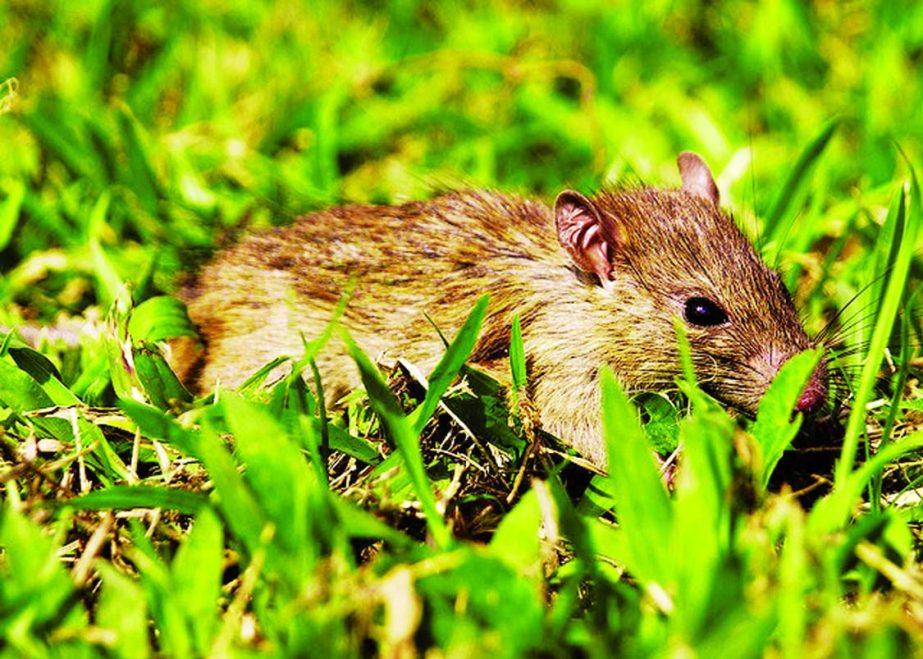
The Renewable Natural Resources Research Strategy (RNRRS) research showed that 5-10 per cent of stored grain was lost to rodents over each 3-month storage period (each household losing 200kg/yr). Contamination with urine and faeces was also severe.
In common with most of Asia, Bangladesh farmers routinely plant 2 rows of rice for the rats for every 8 rows sown (pre-harvest losses ranging from 5-17 per cent). Farmer damage assessments highlighted some of the more overlooked impacts of rodents, namely physical damage to houses, personal possessions, roads and fields.
This damage requires extensive repair time to houses and fields, and significant financial expenditure when clothes, blankets, fishing nets, baskets, utensils, etc are damaged. Ecologically Based Rodent Management (EBRM) strategies were shown to reduce the impact of rodents by 60-80 per cent for different measurable indicators. This was established through comparing intervention villages with non-intervention villages.
Similarly, farmer assessments showed Ecologically Based Rodent Management (EBRM) strategies were roughly the same cost (financial and time) as former practice, but with a much higher benefit (rat population reduced by >80 per cent).
(Source: Rodent Research Project Documents 2006 prepared by BRRI/BARI, NRI (UK), CSIRO (Australia), IRRI and AID-Comilla, a NGO working on the issue.
Damage due to Rodent
Information regarding the impact of rodents has been collected through controlled trials and through discussions with farmers. Through individual and group discussions farmers generally recognised rodents caused multiple problems. The problems mentioned by the four communities surveyed indicated:
“Damage to crops, especially rice. The amount of damage was not routinely assessed by farmers. However, rodents were implicated in damage to rice at transplanting, tillering and ripening stages. Farmer estimates of rodent damage in rice fields ranged wildly from 0 to 100 per cent, with farmers indicating that it varied from year to year, and it was impossible to predict a bad year.”
“Damage to other crops: guava, jackfruit, mango, coconut, bean, potato, chilli, pumpkin, gourds. No crop was considered to be immune from rodent damage. The damage to different vegetables was often related to flowering and fruiting stages and key growth stages. Particularly important with vegetables werefarmer remarks that far more rodent damage than rodent consumption occurred, which directly impacts product saleability.”
“Storage loss. All farmers recognised that rodents were a problem for stored rice. Farmer estimates of post-harvest loss ranged from 5 to 40 per cent with an average of 13 per cent. Despite these remarks on loss, few people went to much trouble to protect their stored rice from rodent attack. Their perception is that rodents can chew through anything and gain access no matter what they do to prevent it. Controlled store loss trials implemented by the project indicated that real losses from rodents are between 10 and 20 per cent of a farmers’ store, varying with store volume and structure.”
“Dirty environment. Rodents were considered to be a major problem in and around households, particularly by women who recognised that rodents can spread general dirt around. However, awareness about specific disease problems and the role of rodents in disease transmission was generally very low. Rodents did occasionally bite people during the night, but reports were low and not considered to be a major problem. Rodents nibbling at and cutting human hair was cited by many women.
“Damage to property. Rodents were cited to damage furniture, clothes, utensils, the foundations of buildings, granaries, electrical cables and other personal items such as medicine and fishing nets. The cost of this damage was clearly identified by most farmers, e.g. a damaged shirt that cost Tk 300.”
“Damage to livestock. Chickens and eggs were damaged as well as livestock feed.”
Post-harvest Losses due to Rodents
Currently University of Greenwich, UK, StichtingDienstLandbouwkundigOnderzoek, Netherlands, AID-Comilla, a national level NGO of Bangladesh, and Modern Rice Milling Unit, Comilla has been implementing a research project titled Assessment of rodenticide use and rodenticide resistance in Bangladesh in order to reduce post-harvest losses with the financial support from NWO/WOTRO Netherlands Organisation for Scientific Research.
The main purpose of the research project is as follows:
In developing countries, rodents have an enormous economic impact on stored produce. In India, it was reported that 6-9 per cent of the stored paddy rice is consumed by rodents.
Recently, it was postulated that 280 million undernourished people could be fed if post-harvest losses by rodents were reduced by 5 per cent. On top of these losses, rodents contaminate much more produce with their droppings which may harbour pathogens. Rodents also cause major damage to storage facilities, which in turn leads to losses by insects and moulds/mycotoxins. Remarkably, quantitative and qualitative losses caused by rodents are rarely taken into account within the food chain in developing countries. For many small-scale farmers, high levels of rodent damage to grain stocks severely limit the potential to sell surplus grain for family income. Medium to large scale farmers may sell significant proportions of their harvest through cooperatives or directly to local or regional market traders. The stockpiling of grain at the local market level is also exposed to high levels of rodent damage as small warehousing facilities are rarely rodent proof.
Bangladesh made significant progress towards poverty reduction over the past decade. During this period the proportion of people living in poverty fell by 9 per cent and was accompanied by marked improvements in other economic and social outcomes. These changes ensued from the country’s strong economic growth which averaged 5 per cent per annum throughout the later part of the 20th century. However, as a result of population growth, Bangladesh entered the new…
Contd on Page 5

